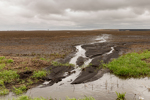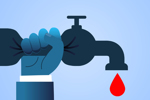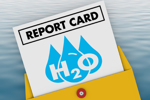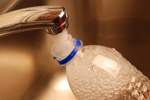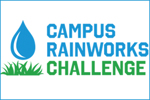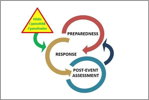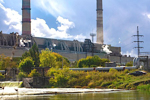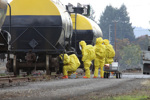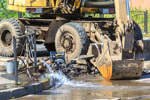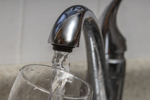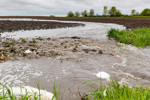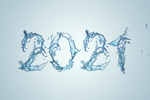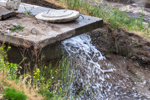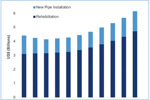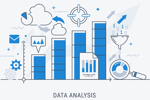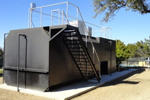ARTICLES BY PETE ANTONIEWICZ
-
Working Toward A More Sustainable Water Future For Tribal Nations1/18/2022
Dating back to colonial times, Native Tribes in North America have often watched wide-ranging access to the land and water of their forefathers diminish over time. Although various policies and settlements have attempted to restore some of those opportunities, the bottom line is that many of today’s tribal territories do not enjoy the same water quality as adjacent states or communities. A new U.S. EPA action plan is designed to narrow that gap.
-
A New Perspective On Funding Nonpoint-Source-Pollution Solutions1/12/2022
While municipal wastewater treatment facilities fight hard to keep waterways clean, other (“nonpoint”) sources contribute greatly to environmental pollution. But there is funding, and now guidance, available to help solve the problem.
-
It's Time To Do Something About Small-System Water Loss1/6/2022
The topic of non-revenue water (NRW) loss often evokes comparisons to the familiar adage about the weather — “it is a matter about which a great deal is said, but very little done.” But such comparisons might soon become obsolete if a no-cost webinar series sponsored by the Environmental Finance Center Network (EFCN) and targeted toward smaller water utilities (<10,000 customers) has anything to do with it. Here’s why.
-
A Water-Treatment Report Card: How Are We Doing?12/22/2021
Faced by ever-changing challenges of water scarcity, source-water quality, regulated discharges, aging infrastructure, economics, and social equality, water- and wastewater-treatment professionals are constantly forced to re-evaluate their efforts and optimize their approaches.
-
Is It Time To Reinforce Confidence In Your Tap Water Quality?10/14/2021
For years, backlash over perceived quality, consumer confidence, and drinking preferences between bottled water vs. tap water has set community water systems back on their heels a bit when it came to water-consumption patterns. Now, new research shows that although consumer preferences are still split, changes in behavior resulting from the COVID pandemic have created new chances for water suppliers to regain some ground. Here’s how.
-
Achieving Better Balance In The Water-Energy-Climate Nexus10/4/2021
Trying to balance urban population growth against water scarcity, energy consumption, and greenhouse gases (GHGs) can feel like being stuck between a rock and a hard place. Fortunately, a recent report quantifying that delicate balance offers new perspective on solutions for water professionals.
-
What The Industry Is Saying About The EPA Contaminant Candidate List 59/28/2021
It is assumed that most individuals involved in the advocacy, treatment, and regulation of drinking water in the U.S. have similar opinions on the importance of delivering clean, safe drinking water. But determining how regulatory steps regarding daily practices at water treatment plants (WTPs) should evolve tends to reveal some differences in opinion. Here are some recent industry reactions to the proposed Drinking Water Contaminant Candidate List 5 (CCL 5).
-
Balancing The Costs Of Water For Utilities And Customers9/7/2021
The cost of municipal water management, including infrastructure renewal, relies on revenue from ratepayers, but affordability of services is a prime concern as well. A recent report from Black & Veatch looks at large cities and recent trends regarding this delicate balance.
-
Next-Generation Solutions To Stormwater And Personnel Challenges7/12/2021
In an industry beleaguered by workforce retirements, costly consent decrees, and climate-induced heavy rainfall events, fresh perspectives and ingenuity are high-profile needs. Fortunately, the U.S. EPA’s Campus RainWorks Challenge is designed to deliver exactly those benefits from the next generation of stormwater specialists. Here’s how current utilities, municipal planners, and consulting-engineer practices all stand to benefit.
-
Promoting Natural Solutions For Urban Stormwater Management7/8/2021
As a continuation of its efforts to help municipalities reduce the negative impacts of stormwater runoff, the U.S. EPA has announced the publication of the last in its series of 12 ‘Barrier Buster’ fact sheets on low-impact development (LID) for urban stormwater management. Here is an overview of how addressing a key gating factor — state and local development codes — can streamline efforts to resolve a wide range of urban stormwater challenges.
-
New Toolkit Arrives Just In Time For HAB Season6/10/2021
With harmful algal blooms (HABs) being forecast to increase, in part due to the effects of climate change, more water systems can expect to face problematic cyanotoxin conditions more frequently and for more days per year. In its efforts to mitigate the negative effects of such increases, the U.S. EPA has enhanced its information resources for water utilities by issuing a new Cyanotoxins Preparedness and Response Toolkit (CPRT).
-
New Methods Extend Options For NPDES Compliance Testing6/10/2021
The National Pollutant Discharge Elimination System (NPDES), introduced as part of the 1972 Clean Water Act, has continued to evolve as new challenges and new technologies emerge. Its latest update, due to go into effect on July 19, 2021, expands the analytical test methods available to governing bodies, industries, and municipalities for compliance reporting under the NPDES permit program. Here is what that entails.
-
Is Your Source Water In Danger? Invest In An Ounce Of Prevention4/22/2021
Despite all of life’s adages about the value of preparation (an ounce of prevention…, a stich in time…, failing to plan…), it’s easy for long-range, source-water-security planning to be deferred because ‘there’s just not enough time or funding to do it right now.’ With the stakes of compromised water quality being so high, however, here are some helpful insights and incentives on why and how to start planning sooner rather than later.
-
Help For Small Water Systems Might Be Closer Than You Thought2/24/2021
Due to limits in personnel or resources, small community water systems often have a tough time funding and implementing needed upgrades. A recent webinar on Leveraging Regional Development Organizations to Support Small Water Systems, hosted by the Environmental Finance Center Network (EFCN), shows how collaboration can make a difference by integrating water-system concerns into a broader approach to overall community concerns.
-
GAO Report Promotes New Way To Advance LSL Remediation1/25/2021
In a report released just days before the U.S. EPA issued its final revisions to the Lead and Copper Rule (LCR), the U.S. Government Accountability Office (GAO) provided insights that water utilities can use to achieve better protections for water customers in neighborhoods at higher risk of lead exposure. Here is a peek into its four recommendations, which the GAO anticipated updating in response to the EPA final LCR revisions.
-
Better Drinking Water Quality Starts Upstream1/12/2021
While every potable water treatment process requires a balance of chemistry and biology to deliver safe, clean drinking water, added concerns from upstream stormwater or agricultural runoff only make the job that much more difficult. How can we do a better job of safeguarding water treatment plant (WTP) operations while protecting the health of water utility customers against threats of upstream nonpoint source (NPS) pollution?
-
Start 2021 With A Splash: Mark Your Calendar With These Opportunities!12/29/2020
While a lot of water-industry education has to do with biology, chemistry, and physics; pumps and piping; or instrumentation and information networks, there is also a broader need to educate consumers on the value of water and their role in protecting it in an ever-changing world. Here are some essential resources and events to help address a broad range of internal and external awareness and education needs in 2021.
-
Brainstorming New Ideas For Improved Stormwater Infrastructure12/16/2020
Planning how to address environment-impacting, water-infrastructure challenges — reducing stormwater runoff pollution, reducing sewer overflows, and protecting rivers and streams that serve as drinking water supplies for downstream towns — can be an intimidating task. A recent report from the Environment America Research & Policy Center cites many examples that can serve as beacons for municipalities large and small.
-
Are Your Customers Turning Up Their Noses At Your Drinking Water?12/11/2020
There have been a number of surveys on water-utility customer satisfaction over the past few decades and, unfortunately, the news tends to be less encouraging than it should be. Is it safe to chalk up those responses to personal tastes or preferences, or is it time to do something about turning them around before it’s too late? Here are some resources to consider.
-
Giving Thanks For Water Advocates' Big-Picture Thinking11/30/2020
Confronted by everyday operating challenges, many decision-makers at drinking water and wastewater organizations do not always have all the time they would like to develop big-picture strategies and tactics for current and long-term concerns. Fortunately, multiple dedicated water-advocacy organizations do. Here are seven areas where water strategists, decision-makers, and other leaders can benefit from those valuable insights.
-
Trenchless Technology Poised To Advance Infrastructure Resiliency11/23/2020
As one of many ripple effects of COVID-19, capital investment in water and wastewater infrastructure is expected to see some setbacks due to reductions in revenue and cash flow during the pandemic. But a recent report highlights a brighter picture for the growth of trenchless technology in pipeline repair expenditures, thanks to its cost-effective approach for meeting pent-up demand.
-
Data Science Aids Lead-Service-Line Inventory And Replacement Programs10/7/2020
A white paper recently released by the Association of State Drinking Water Administrators (ASDWA) provides insights on how water utilities can better use data to manage uncertainty around remaining lead-service-line (LSL) customer connections. The document represents the organization’s commitment to making information accessible to assist state program administrators in protecting public health.
-
Taking Stock Of The Value In Distributed Water Infrastructure10/5/2020
In the spirit of ‘never let a good crisis go to waste,’ a recent addition to the Pacific Institute website calls attention to the merits of distributed water infrastructure as a practical response to financial challenges caused by the COVID-19 crisis and other such financially stressful events. This overview includes links to strategic and tactical references to help water-utility decision-makers improve their resiliency.
-
A Good Time To Reassess Utility Resiliency9/9/2020
The Water Information Sharing and Analysis Center (WaterISAC) is reminding water utilities that September is National Preparedness Month in an effort to focus attention on steps they can take to improve resiliency and be prepared for a variety of challenges to their continuity of operations. Here are some industry guidelines and valuable links to help that happen.
-
Adapting To The 'New Normal' In A Post-COVID Water Sector9/5/2020
Beyond all the health-related impacts of the coronavirus pandemic, there have been some ripple effects to the daily operations and related employment conditions for water-treatment personnel. Here is a recap of some of those issues, their impacts, and alternatives for water-utility management.
-
Proposed Defense Bill Includes Improved Focus On PFAS Control8/6/2020
The U.S. House of Representatives’ version of the National Defense Authorization Act (NDAA) for Fiscal Year 2021 (H.R. 6395) includes some positive developments for communities and community water systems impacted by contamination from per- and polyfluorinated substances (PFAS) used at nearby Department of Defense (DoD) installations. Here are some insights on potential benefits for water consumers in those areas.
-
Packaged Wastewater Treatment: A Recipe For Success6/22/2020
Food and beverage wastewater treatment demands often fluctuate more drastically than municipal wastewater applications in terms of biochemical oxygen demand (BOD) relating to the foods being processed or to cyclical activity. Modular, self-contained systems offer practical, cost-effective solutions to help food processors keep pace with such variability — as a total or supplemental solution. Here’s how.
-
Water Industry Responds To Proposed LCR Revisions2/21/2020
With more than 50,000 community water systems (CWS) in the U.S., it is amazing that only 285 individuals had logged public comments on the U.S. EPA’s proposed Lead and Copper Rule (LCR) Revisions by the February 12, 2020 deadline. Yet, what those respondents had to say could have a big impact on how we deal with lead in drinking water moving forward. Here is a cross-section of the industry’s response.
-
50+ Links To Assist Small, Stressed Water Utilities1/29/2020
While any drinking water or wastewater treatment operation can be challenged by demands from changing seasonal conditions or regulatory requirements, those pressures can quickly compound for personnel forced to wear multiple hats at small- to medium-sized utilities. Here are scores of links to helpful resources for such operators for the municipalities and consulting engineers who work with them.
-
LCR Revisions: Speak Now, Or Forever Hold Your Peace1/29/2020
Are you completely ready to implement the scores of changes in the U.S. EPA’s Lead and Copper Rule Revisions (LCRR), exactly as proposed? If not, act quickly, because time to register constructive feedback before the February 12th deadline is running out. Less than three weeks before the end of the comment period, the EPA’s webpage for feedback displayed only 131 public submissions regarding the proposed regulations.



